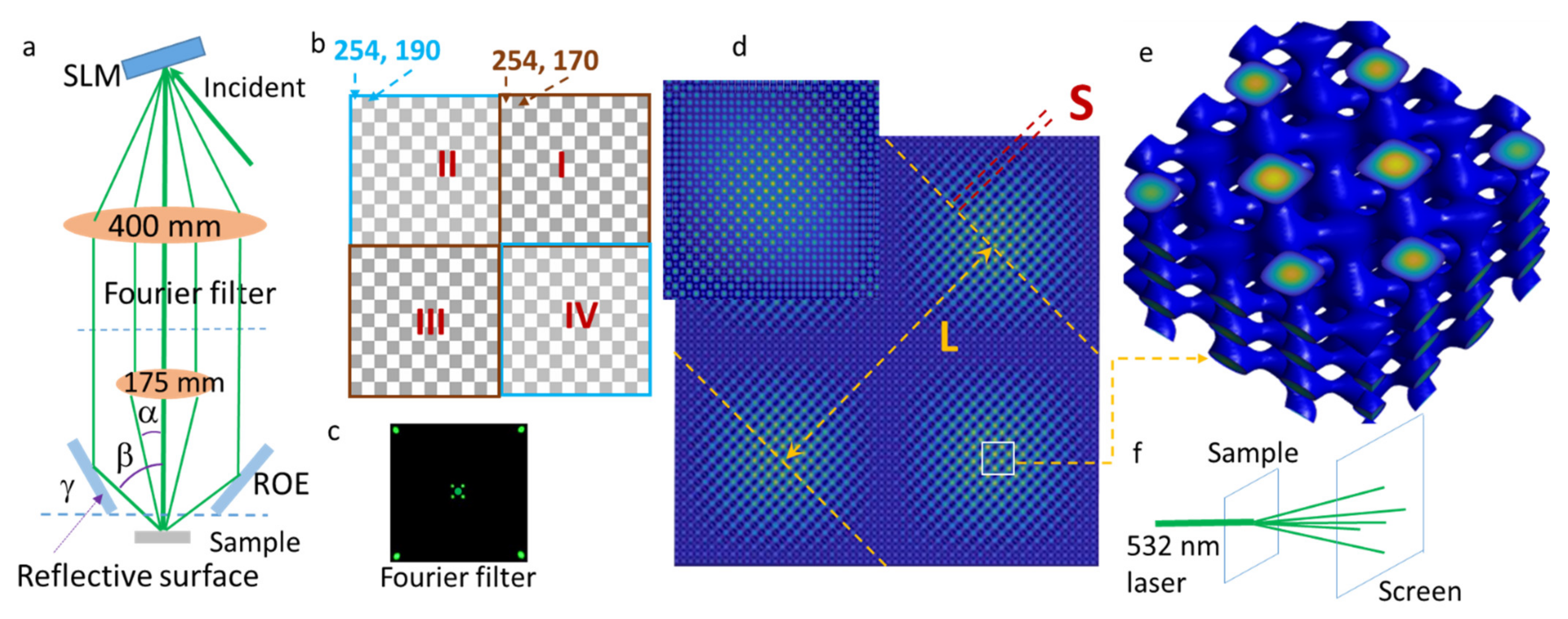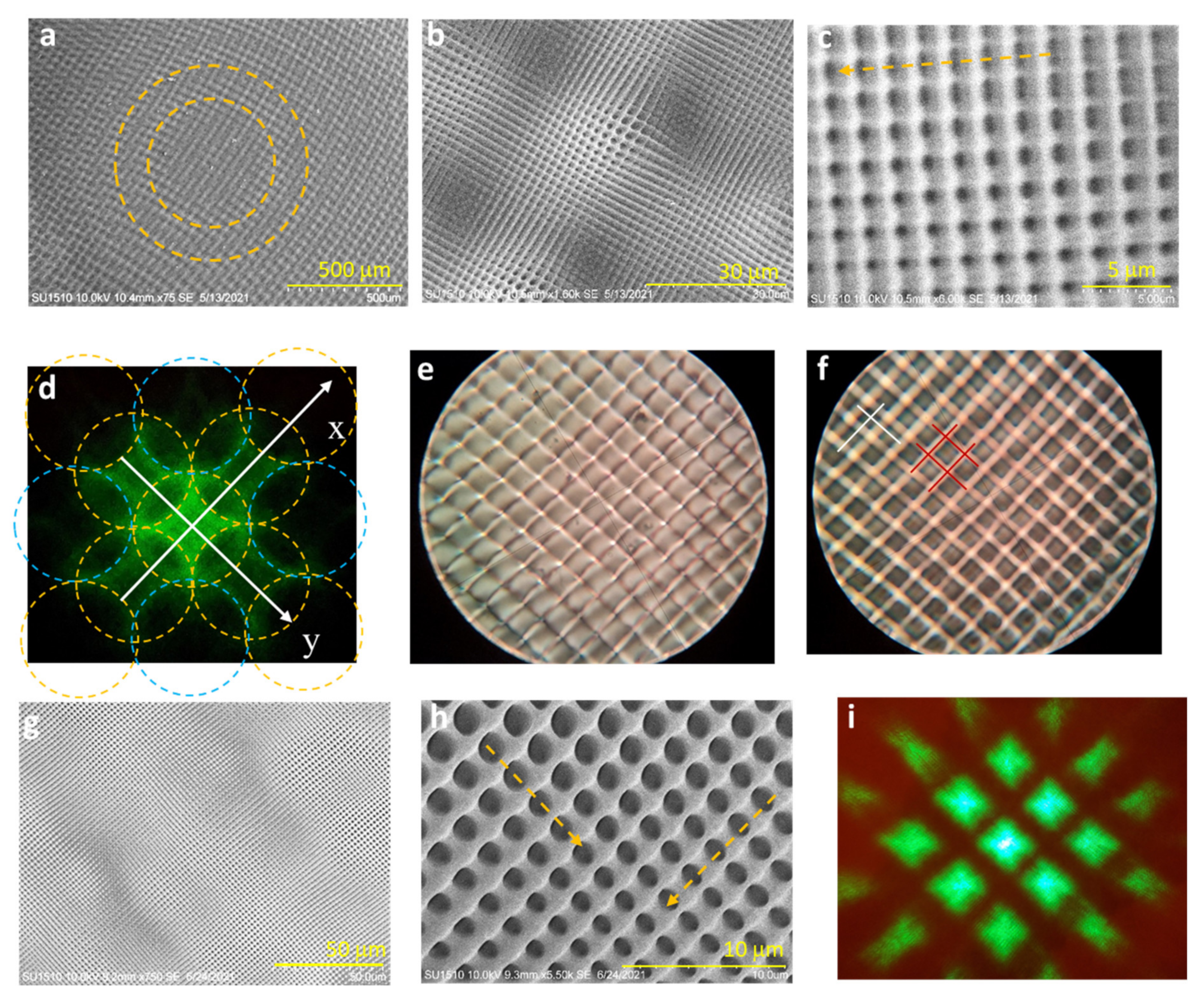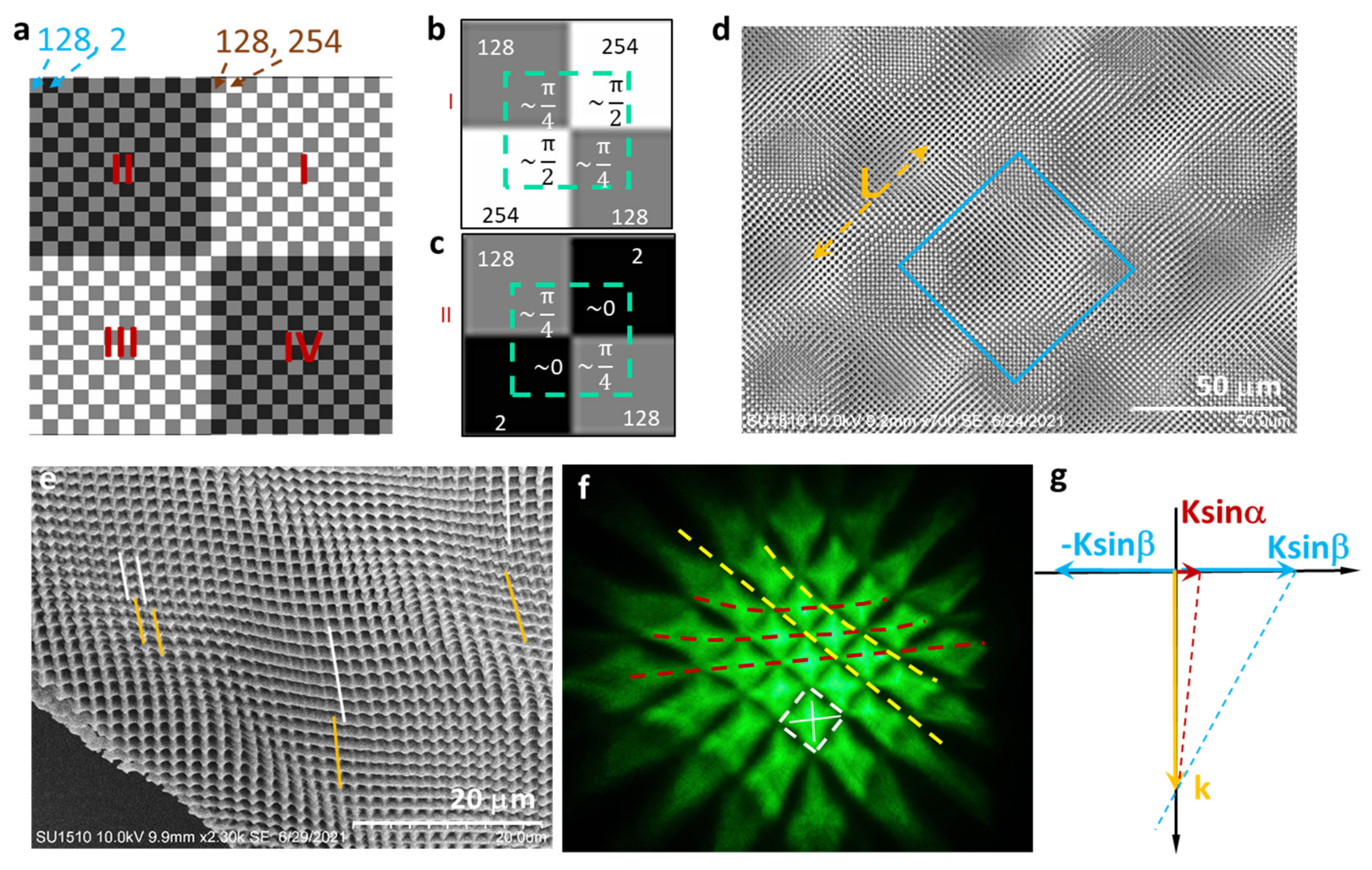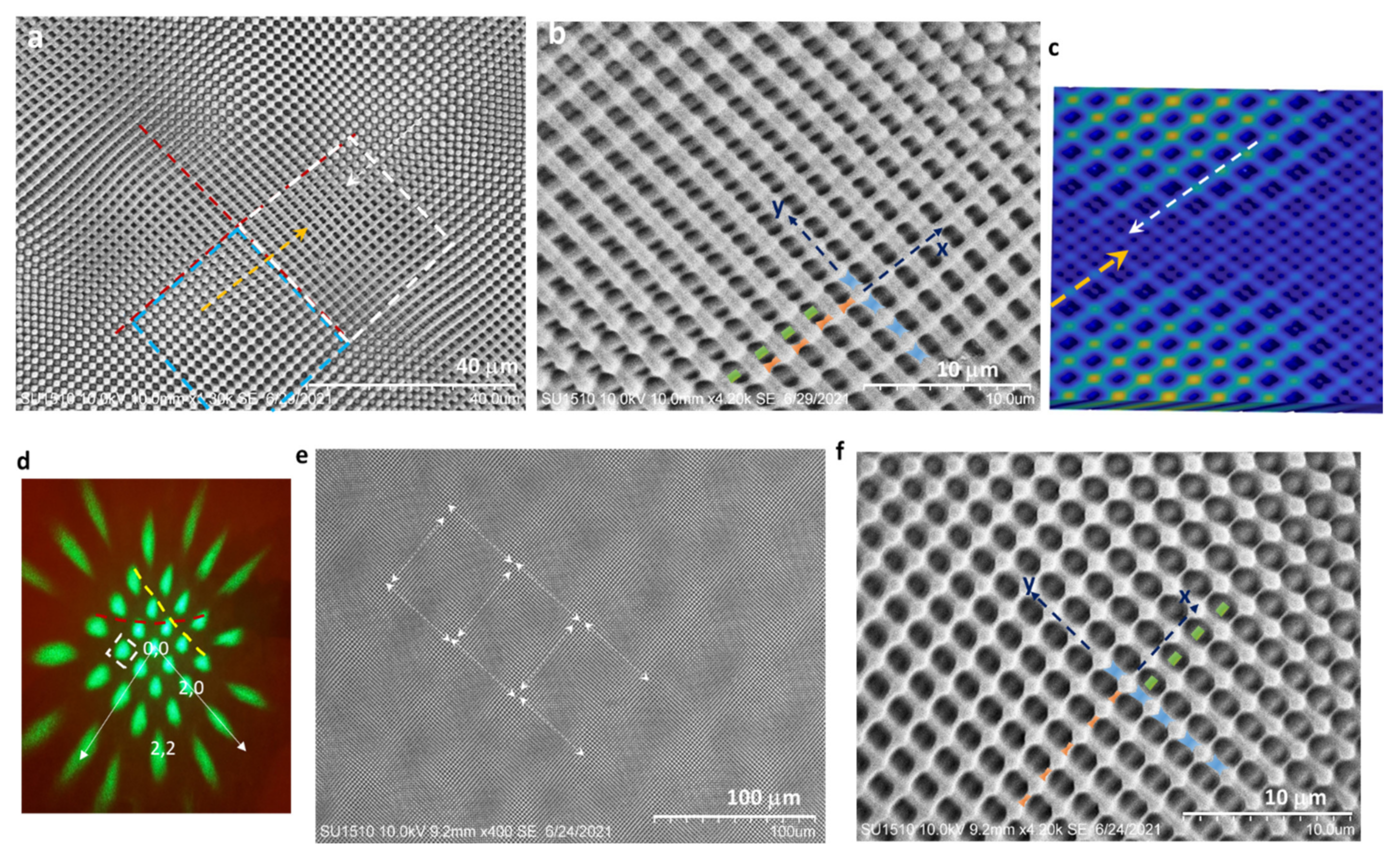Laser Diffraction Zones and Spots from Three-Dimensional Graded Photonic Super-Crystals and Moiré Photonic Crystals
Abstract
:1. Introduction
2. Experimental Methods and Theoretic Description
3. Results
3.1. Diffraction Zone Pattern from Holographic Structures Fabricated with Type-1 Phase Pattern ((254, 190), (254, 170))
3.2. Diffraction Zone Pattern from Holographic Structures Fabricated with Type-2 Phase Pattern ((128, 2), (128, 254))
3.3. Diffraction Zone Pattern from Holographic Structures Fabricated with Type-3 Phase Pattern ((128, 2), (254, 128))
4. Discussion
5. Conclusions
Author Contributions
Funding
Institutional Review Board Statement
Informed Consent Statement
Data Availability Statement
Conflicts of Interest
References
- John, S. Strong Localization of Photons in Certain Disordered Dielectric Superlattices. Phys. Rev. Lett. 1987, 58, 2486–2489. [Google Scholar] [CrossRef] [PubMed] [Green Version]
- Akahane, Y.; Asano, T.; Song, B.S.; Noda, S. High-Q Photonic Nanocavity in a Two-Dimensional Photonic Crystal. Nature 2003, 425, 944–947. [Google Scholar] [CrossRef] [PubMed]
- Tandaechanurat, A.; Ishida, S.; Guimard, D.; Nomura, M.; Iwamoto, S.; Arakawa, Y. Lasing Oscillation in a Three-Dimensional Photonic Crystal Nanocavity with a Complete Bandgap. Nat. Photonics 2011, 5, 91–94. [Google Scholar] [CrossRef] [Green Version]
- Delgoffe, A.; Miranda, A.; Rigal, B.; Lyasota, A.; Rudra, A.; Dwir, B.; Kapon, E. Tilted-Potential Photonic Crystal Cavities for Integrated Quantum Photonics. Opt. Express 2019, 27, 21822–21833. [Google Scholar] [CrossRef]
- Perczel, J.; Borregaard, J.; Chang, D.E.; Yelin, S.F.; Lukin, M.D. Topological Quantum Optics Using Atomlike Emitter Arrays Coupled to Photonic Crystals. Phys. Rev. Lett. 2020, 124, 83603–83610. [Google Scholar] [CrossRef] [Green Version]
- Kim, S.; Fröch, J.E.; Christian, J.; Straw, M.; Bishop, J.; Totonjian, D.; Watanabe, K.; Taniguchi, T.; Toth, M.; Aharonovich, I. Photonic Crystal Cavities from Hexagonal Boron Nitride. Nat. Commun. 2018, 9, 2623. [Google Scholar] [CrossRef]
- Bhattacharya, S.; Baydoun, I.; Lin, M.; John, S. Towards 30% Power Conversion Efficiency in Thin-Silicon Photonic-Crystal Solar Cells. Phys. Rev. Appl. 2019, 11, 14005–14031. [Google Scholar] [CrossRef] [Green Version]
- Liu, W.; Ma, H.; Walsh, A. Advance in Photonic Crystal Solar Cells. Renew. Sustain. Energy Rev. 2019, 116, 109436. [Google Scholar] [CrossRef]
- Hassan, S.; Alnasser, K.; Lowell, D.; Lin, Y. Effects of Photonic Band Structure and Unit Super-Cell Size in Graded Photonic Super-Crystal on Broadband Light Absorption in Silicon. Photonics 2019, 6, 50. [Google Scholar] [CrossRef] [Green Version]
- Maho, A.; Lobet, M.; Daem, N.; Piron, P.; Spronck, G.; Loicq, J.; Cloots, R.; Colson, P.; Henrist, C.; Dewalque, J. Photonic Structuration of Hybrid Inverse-Opal TiO2- Perovskite Layers for Enhanced Light Absorption in Solar Cells. ACS Appl. Energy Mater. 2021, 4, 1108–1119. [Google Scholar] [CrossRef]
- Lobet, M.; Piron, P.; Dewalque, J.; Maho, A.; Deparis, O.; Henrist, C.; Loicq, J. Efficiency Enhancement of Perovskite Solar Cells Based on Opal-like Photonic Crystals. Opt. Express 2019, 27, 32308–32322. [Google Scholar] [CrossRef]
- Hwang, D.K.; Lee, B.; Kim, D.H. Efficiency Enhancement in Solid Dye-Sensitized Solar Cell by Three-Dimensional Photonic Crystal. RSC Adv. 2013, 3, 3017–3023. [Google Scholar] [CrossRef]
- Kim, Y.D.; Han, K.-H.; Park, S.-J.; Kim, J.-B.; Shin, J.-H.; Kim, J.J.; Lee, H. Enhanced Light Extraction Efficiency in Organic Light Emitting Diodes Using a Tetragonal Photonic Crystal with Hydrogen Silsesquioxane. Opt. Lett. 2014, 39, 5901–5904. [Google Scholar] [CrossRef]
- Ishihara, K.; Fujita, M.; Matsubara, I.; Asano, T.; Noda, S.; Ohata, H.; Hirasawa, A.; Nakada, H.; Shimoji, N. Organic Light-Emitting Diodes with Photonic Crystals on Glass Substrate Fabricated by Nanoimprint Lithography. Appl. Phys. Lett. 2007, 90, 111114. [Google Scholar] [CrossRef]
- Zhang, Y.; Biswas, R. High Light Outcoupling Efficiency from Periodically Corrugated OLEDs. ACS Omega 2021, 6, 9291–9301. [Google Scholar] [CrossRef]
- Hassan, S.; Lowell, D.; Lin, Y. High Light Extraction Efficiency into Glass Substrate in Organic Light-Emitting Diodes by Patterning the Cathode in Graded Superlattice with Dual Periodicity and Dual Basis. J. Appl. Phys. 2017, 121, 233104. [Google Scholar] [CrossRef]
- Alnasser, K.; Hassan, S.; Kamau, S.; Zhang, H.; Lin, Y. Enhanced Light Extraction from Organic Light-Emitting Diodes by Reducing Plasmonic Loss through Graded Photonic Super-Crystals. J. Opt. Soc. Am. B 2020, 37, 1283–1289. [Google Scholar] [CrossRef]
- Ning, H.; Pikul, J.H.; Zhang, R.; Li, X.; Xu, S.; Wang, J.; Rogers, J.A.; King, W.P.; Braun, P.V. Holographic Patterning of High-Performance on-Chip 3D Lithium-Ion Microbatteries. Proc. Natl. Acad. Sci. USA 2015, 112, 6573–6578. [Google Scholar] [CrossRef] [Green Version]
- Kamali, S.M.; Arbabi, E.; Kwon, H.; Faraon, A. Metasurface-Generated Complex 3-Dimensional Optical Fields for Interference Lithography. Proc. Natl. Acad. Sci. USA 2019, 116, 21379–21384. [Google Scholar] [CrossRef] [Green Version]
- Jeon, T.; Kim, D.H.; Park, S.G. Holographic Fabrication of 3D Nanostructures. Adv. Mater. Interfaces 2018, 5, 1800330. [Google Scholar] [CrossRef]
- Lin, Y.; Herman, P.R.; Darmawikarta, K. Design and Holographic Fabrication of Tetragonal and Cubic Photonic Crystals with Phase Mask: Toward the Mass-Production of Three-Dimensional Photonic Crystals. Appl. Phys. Lett. 2005, 86, 071117. [Google Scholar] [CrossRef]
- Park, H.; Lee, S. Double Gyroids for Frequency-Isolated Weyl Points in the Visible Regime and Interference Lithographic Design. ACS Photonics 2020, 7, 1577–1585. [Google Scholar] [CrossRef]
- Sun, X.; Wu, F.; Wang, S.; Qi, Y.; Zeng, Y. Design of Gradient Photonic Crystal Lens Array Using Two-Parameter Hexagonal Prism Interferometer. Guangxue Xuebao/Acta Opt. Sin. 2020, 40, 0222002. [Google Scholar] [CrossRef]
- Behera, S.; Joseph, J. Single-Step Optical Realization of Bio-Inspired Dual-Periodic Motheye and Gradient-Index-Array Photonic Structures. Opt. Lett. 2016, 41, 3579–3582. [Google Scholar] [CrossRef]
- Lowell, D.; Hassan, S.; Sale, O.; Adewole, M.; Hurley, N.; Philipose, U.; Chen, B.; Lin, Y. Holographic Fabrication of Graded Photonic Super-Quasi-Crystals with Multiple-Level Gradients. Appl. Opt. 2018, 57, 6598–6604. [Google Scholar] [CrossRef]
- Hassan, S.; Sale, O.; Lowell, D.; Hurley, N.; Lin, Y. Holographic Fabrication and Optical Property of Graded Photonic Super-Crystals with a Rectangular Unit Super-Cell. Photonics 2018, 5, 34. [Google Scholar] [CrossRef] [Green Version]
- Lowell, D.; Hassan, S.; Adewole, M.; Philipose, U.; Chen, B.; Lin, Y. Holographic Fabrication of Graded Photonic Super-Crystals Using an Integrated Spatial Light Modulator and Reflective Optical Element Laser Projection System. Appl. Opt. 2017, 56, 9888–9891. [Google Scholar] [CrossRef]
- Sale, O.; Hassan, S.; Hurley, N.; Alnasser, K.; Philipose, U.; Zhang, H.; Lin, Y. Holographic Fabrication of Octagon Graded Photonic Supercrystal and Potential Applications in Topological Photonics. Front. Optoelectron. 2020, 13, 12–17. [Google Scholar] [CrossRef]
- Oudich, M.; Su, G.; Deng, Y.; Benalcazar, W.; Huang, R.; Gerard, N.J.R.K.; Lu, M.; Zhan, P.; Jing, Y. Photonic Analog of Bilayer Graphene. Phys. Rev. B 2021, 103, 214311–214321. [Google Scholar] [CrossRef]
- Lou, B.; Zhao, N.; Minkov, M.; Guo, C.; Orenstein, M.; Fan, S. Theory for Twisted Bilayer Photonic Crystal Slabs. Phys. Rev. Lett. 2021, 126, 136101–136107. [Google Scholar] [CrossRef]
- Dong, K.; Zhang, T.; Li, J.; Wang, Q.; Yang, F.; Rho, Y.; Wang, D.; Grigoropoulos, C.P.; Wu, J.; Yao, J. Flat Bands in Magic-Angle Bilayer Photonic Crystals at Small Twists. Phys. Rev. Lett. 2021, 126, 223601–223607. [Google Scholar] [CrossRef] [PubMed]
- Alnasser, K.; Kamau, S.; Hurley, N.; Cui, J.; Lin, Y. Photonic Band Gaps and Resonance Modes in 2d Twisted Moiré Photonic Crystal. Photonics 2021, 8, 408. [Google Scholar] [CrossRef]
- Alnasser, K.; Kamau, S.; Hurley, N.; Cui, J.; Lin, Y. Resonance Modes in Moiré Photonic Patterns for Twistoptics. OSA Contin. 2021, 4, 1339–1347. [Google Scholar] [CrossRef]
- Lowell, D.; Lutkenhaus, J.; George, D.; Philipose, U.; Chen, B.; Lin, Y. Simultaneous Direct Holographic Fabrication of Photonic Cavity and Graded Photonic Lattice with Dual Periodicity, Dual Basis, and Dual Symmetry. Opt. Express 2017, 25, 14444–14452. [Google Scholar] [CrossRef]
- Ohlinger, K.; Lutkenhaus, J.; Arigong, B.; Zhang, H.; Lin, Y. Spatially Addressable Design of Gradient Index Structures through Spatial Light Modulator Based Holographic Lithography. J. Appl. Phys. 2013, 114, 23102. [Google Scholar] [CrossRef]
- Case, W.B.; Tomandl, M.; Deachapunya, S.; Arndt, M. Realization of Optical Carpets in the Talbot and Talbot-Lau Configurations. Opt. Express 2009, 17, 20966–20974. [Google Scholar] [CrossRef]
- Hassan, S.; Jiang, Y.; Alnasser, K.; Hurley, N.; Zhang, H.; Philipose, U.; Lin, Y. Generation of over 1000 Diffraction Spots from 2D Graded Photonic Super-Crystals. Photonics 2020, 7, 27. [Google Scholar] [CrossRef] [Green Version]
- Lowell, D.; George, D.; Lutkenhaus, J.; Tian, C.; Adewole, M.; Philipose, U.; Zhang, H.; Lin, Y. Flexible Holographic Fabrication of 3D Photonic Crystal Templates with Polarization Control through a 3D Printed Reflective Optical Element. Micromachines 2016, 7, 128. [Google Scholar] [CrossRef] [Green Version]
- George, D.; Lutkenhaus, J.; Lowell, D.; Moazzezi, M.; Adewole, M.; Philipose, U.; Zhang, H.; Poole, Z.L.; Chen, K.P.; Lin, Y. Holographic Fabrication of 3D Photonic Crystals through Interference of Multi-Beams with 4 + 1, 5 + 1 and 6 + 1 Configurations. Opt. Express 2014, 22, 22421. [Google Scholar] [CrossRef]
- Tétreault, N.; Von Freymann, G.; Deubel, M.; Hermatschweiler, M.; Pérez-Willard, F.; John, S.; Wegener, M.; Ozin, G.A. New Route to Three-Dimensional Photonic Bandgap Materials: Silicon Double Inversion of Polymer Templates. Adv. Mater. 2006, 18, 457. [Google Scholar] [CrossRef] [Green Version]
- Pierangeli, D.; Ferraro, M.; Di Mei, F.; Di Domenico, G.; De Oliveira, C.E.M.; Agranat, A.J.; DelRe, E. Super-Crystals in Composite Ferroelectrics. Nat. Commun. 2016, 7, 10674. [Google Scholar] [CrossRef] [Green Version]




| Diffraction Zone Order | Diffraction Efficiency (%) |
|---|---|
| (0, 0) | 9.9 |
| (1, 0) | 6.0 |
| (2, 0) | 4.8 |
| (1, 1) | 3.7 |
| (2, 1) | 2.8 |
| (2, 2) | 2.6 |
Publisher’s Note: MDPI stays neutral with regard to jurisdictional claims in published maps and institutional affiliations. |
© 2022 by the authors. Licensee MDPI, Basel, Switzerland. This article is an open access article distributed under the terms and conditions of the Creative Commons Attribution (CC BY) license (https://creativecommons.org/licenses/by/4.0/).
Share and Cite
Hurley, N.; Kamau, S.; Alnasser, K.; Philipose, U.; Cui, J.; Lin, Y. Laser Diffraction Zones and Spots from Three-Dimensional Graded Photonic Super-Crystals and Moiré Photonic Crystals. Photonics 2022, 9, 395. https://doi.org/10.3390/photonics9060395
Hurley N, Kamau S, Alnasser K, Philipose U, Cui J, Lin Y. Laser Diffraction Zones and Spots from Three-Dimensional Graded Photonic Super-Crystals and Moiré Photonic Crystals. Photonics. 2022; 9(6):395. https://doi.org/10.3390/photonics9060395
Chicago/Turabian StyleHurley, Noah, Steve Kamau, Khadijah Alnasser, Usha Philipose, Jingbiao Cui, and Yuankun Lin. 2022. "Laser Diffraction Zones and Spots from Three-Dimensional Graded Photonic Super-Crystals and Moiré Photonic Crystals" Photonics 9, no. 6: 395. https://doi.org/10.3390/photonics9060395
APA StyleHurley, N., Kamau, S., Alnasser, K., Philipose, U., Cui, J., & Lin, Y. (2022). Laser Diffraction Zones and Spots from Three-Dimensional Graded Photonic Super-Crystals and Moiré Photonic Crystals. Photonics, 9(6), 395. https://doi.org/10.3390/photonics9060395







